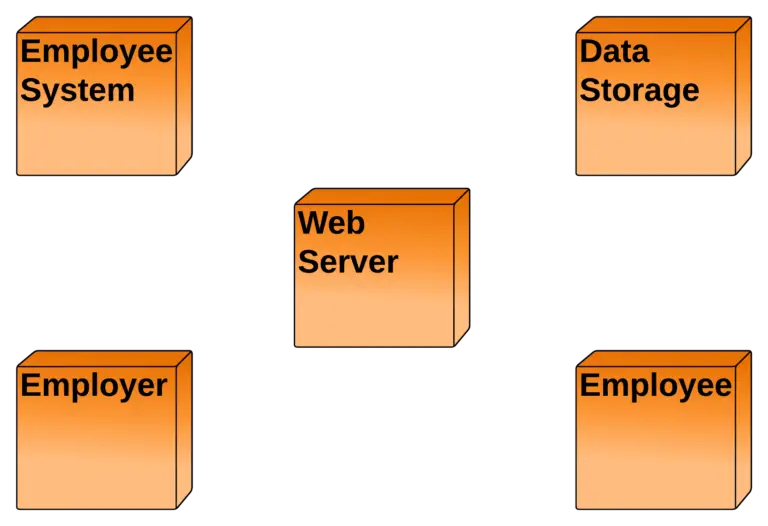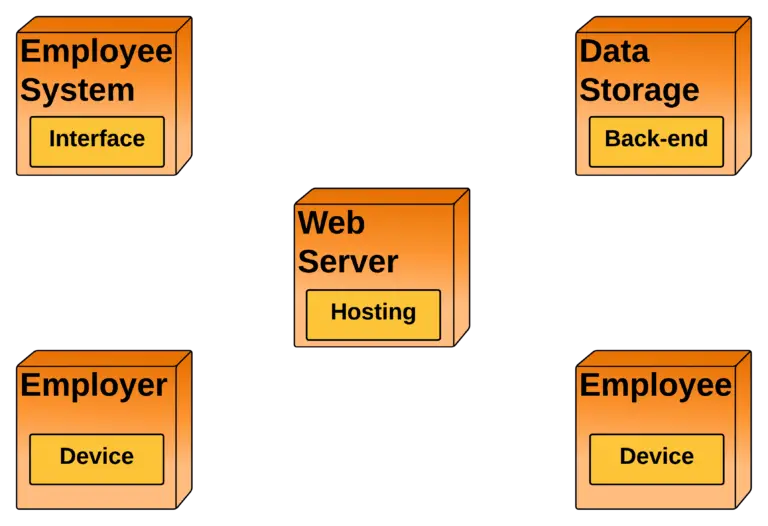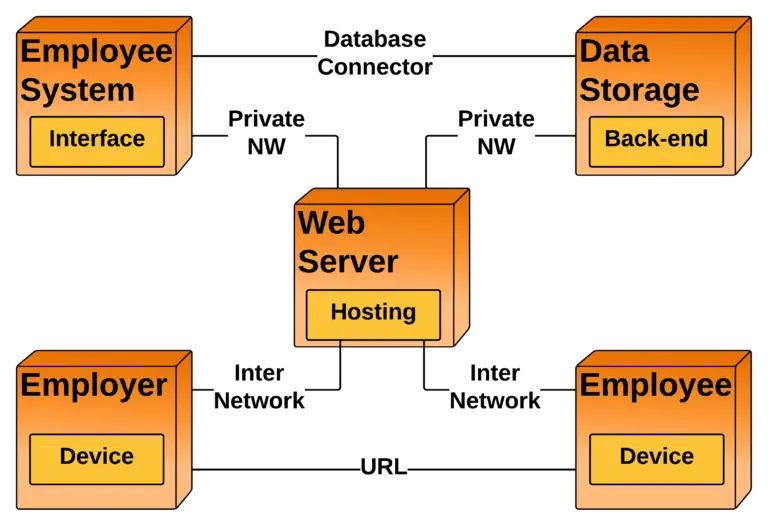Deployment Diagram for Employee Management System
The deployment diagram for employee management system is used to represent the system’s physical architecture showing the included nodes and their associations. UML deployment diagram nodes are composed of hardware and software components that serve as primary requirements to carry out the employee management.
Employee Management System Deployment Diagram: Table of contents
- Deployment Diagram for Employee Management System
- Deployment Diagram for Employee Management System: Content
- Employee Management System Deployment Diagram Description
- UML Deployment Diagram for Employee Management System
- Deployment Diagram for Employee Management System
- Employee Management System UML Deployment Diagram (Explanation)
- Deployment Diagram for Employee Management System (PDF)
- Advantages of Employee System Deployment Diagram
- Steps in Developing Employee Management System Deployment Diagram
- Additional Knowledge
- Conclusion
- Related Articles:
- Recommended Articles from the Author:
- Inquiries
Deployment Diagram for Employee Management System: Content
The table shows the basic details of the deployment diagram of the employee management system. It has quick description details of the project.
| Name: | Employee Management System Deployment Diagram |
| Abstract: | The employee management system deployment diagram represents the physical structure of the project. It reveals the software and hardware included for the application to work correctly. |
| UML Diagram: | Deployment Diagram |
| Users: | Company Admin or Employers and Employees. |
| Tools Used: | Diagraming Tools that have UML Deployment Diagram Symbols |
| Designer: | ITSourceCode.com |
Employee Management System Deployment Diagram Description
An employee management system is a designed software to keep up with employees’ information in an establishment. This software keeps track of their employees’ information and the specifics of their payroll system allowing them to issue payroll information.
The software has the complete set of employee management tools that a company needs to keep track of employee information, engagement, and performance, as well as make more money for the whole company.
The employee system also directs and supervises the activities of employees in the appropriate direction. Keeps and manages information that is important to your employees in a safe way, like personal and work-related information.
UML Deployment Diagram for Employee Management System
A deployment diagram for employee system in UML is used to illustrate its’ physical architecture. In UML, deployment diagrams can show you how the software and hardware of the learning system work together and where the processing takes place.
The employee management system uses a UML deployment diagram to show how should the developed software be deployed. It clarifies the communications between links(nodes) which helps the project to work according to the design given to it. Deployment diagrams depict the setup of run-time processing nodes and the components that reside on them.
Deployment Diagram for Employee Management System
The designed deployment diagram for employee system shows the components (nodes) included to carry out the process. Nodes are represented by boxes that are labeled as software or hardware that specify the included components to carry out the employee management process. The boxes will then be connected and labeled to declare the type of connection they have with the other components.

This deployment diagram design helps in the system development. This leads to scenarios where companies gain insights into their employees using an employee management system allowing them to better plan and manage work hours, lowering labor expenses and increasing productivity. This strategy will assist employees in doing their best work each day in order to meet the organization’s wider goals.
Employee Management System UML Deployment Diagram (Explanation)
The Employee Management System UML deployment diagram explains the sketch of the relationship between software and hardware. These hardware and software are labeled to clarify their part in the system’s operation. They were represented by nodes and the connections were represented by labeled arrows.
The deployment diagram shows the scenario when the system is deployed. It has 5 nodes represented with boxes and relationship connections. The nodes are the employee management system, the browser, the employer’s device, the employee’s device, and the database (system server). The system server node contains a developed database that will hold the details of the system online.
For the connection, the system is connected to the server database using a private network which enables it to pass a connection to the devices and enable users to access the system and database. The employer and the employees then can communicate through the system.
Deployment Diagram for Employee Management System (PDF)
You may download the Deployment Diagram for Employee System PDF by clicking the button below. It has the full details and discussion on System’s Deployment Diagram. You can also modify its content to complete your project requirements and needs.
Advantages of Employee System Deployment Diagram
- Portrays the deployment view of the employee management system.
- Helps in visualizing the topological view of the employee management system.
- Models the physical architecture of the employee management system.
- Shows the relationships between the software and hardware components in the employee management system.
- Shows the physical distribution of the system’s processing.
Steps in Developing Employee Management System Deployment Diagram
Time needed: 10 minutes
Here are the steps in developing the employee management system deployment diagram.
- Determine the diagram’s purpose.
To determine the purpose of the deployment diagram, know the description of the employee system. The purpose of the deployment diagram is to design the needed components (software and hardware) of the system. This is to support and imply the whole processes when the employee management system operates.
- Add the diagram’s nodes.
The term “node” refers to the physical devices that make up the system. Artifacts are deployed on these nodes. Node instances on which artifact instances will be implemented are also possible.

The essential software or hardware elements, or nodes, in the system are represented by the three-dimensional boxes known as nodes. The smaller forms included within the boxes reflect the software artifacts that are distributed, and the lines from node to node indicate relationships. - Add more pieces to the diagram, such as components or artifacts, if needed.
A deployment diagram depicts the locations of components and artifacts in the deployed system. In a software system, artifacts are model elements that reflect physical entities. Executable files, libraries, software components, documents, and databases are examples of physical implementation units.

- Add communication associations.
A communication association (path) is a sort of relationship between nodes in a deployment diagram that indicates how they communicate messages and signals in UML modeling. Deploy relationships in UML show that a certain type of node can be used to deploy a certain type of artifact.

A message or other sort of communication between nodes is indicated by a line called a relation or association.
Additional Knowledge
The topology of the physical components of a system, where the software components are installed, is visualized using deployment diagrams. Deployment diagrams are used to depict a system’s static deployment view. Nodes and their relationships are depicted in deployment diagrams.
The Deployment Model shows how components will be distributed across the system architecture in detail. It contains information about network capabilities, server specifications, hardware requirements, and other aspects of the planned system’s deployment.
Conclusion
You need to know the diagrams used to design and develop the Employee Management System. That is because you cannot perfectly create a fully-functional system without it. But if you create this deployment diagram, you will know the software and hardware components that the project should possess. Not only that, you will find out the needed specifications and connect them to the other UML Diagrams.
The deployment diagram is used to model the system’s physical architecture. It describes the connections of components between software and hardware system. By completing the Diagrams per module or per process, you will easily achieve your desired system. Check out our Related and Recommended Articles for more Learning and Information.
Related Articles:
- Deployment Diagram for Student Management System
- Deployment Diagram for Point of Sale System
- Deployment Diagram for Student Attendance Management
- Deployment Diagram for Online Examination System
- Deployment Diagram for Payroll Management System
Recommended Articles from the Author:
- Employee Management System UML Diagrams
- Employee Management System Project Report
- DFD (Data Flow Diagram) for Employee Management System
- Employee Attendance Management System Project Report
Inquiries
If you have inquiries or suggestions about Deployment Diagram for Employee Management System, just leave us your comments below. We would be glad to hear to concerns and suggestions and be part of your learning.
Keep us updated and Good day!




